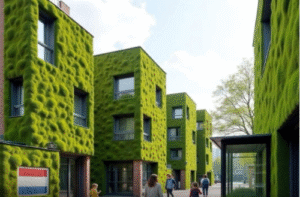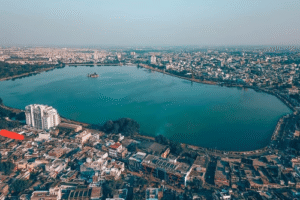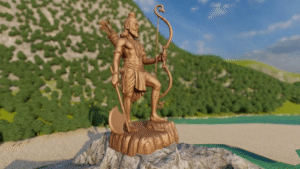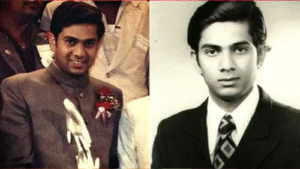Rani ki Vav (Queen’s Stepwell), located in Patan, Gujarat, is an architectural marvel and one of the most exquisite examples of ancient Indian water management and sculpture. It was built by Rani Udayamati, the queen of Bhimadeva I of the Chalukya dynasty, in the 11th century to commemorate her late husband. The stepwell is not just a functional structure but also a monumental expression of art and devotion.
The stepwell measures approximately 65 meters (213 feet) in length, 20 meters (65 feet 7 inches) in width, and is about 28 meters (91 feet 10 inches) deep.
The stepwell was designed to access the underground water table, especially important in the arid region of Gujarat.
It was originally constructed with a multi-story design, with steps leading down to the water level, which was ideal for climatic conditions and seasonal water availability.
Rani ki Vav is an exceptional example of Indian stepwell architecture, showcasing the advanced engineering skills of its time.
It features a reverse stepwell design, where the well is vertical and the steps extend downward to reach the water.
The intricate and elaborate carvings on the walls of the stepwell are a remarkable example of medieval Indian art, with detailed depictions of gods, goddesses, and mythological scenes.
The stepwell is known for its more than 800 sculptures, including depictions of Hindu gods, godly figures, and royal court scenes.
The sculptures depict a combination of mythological themes, including episodes from Ramayana, Mahabharata, and other Hindu texts.
The stepwell’s structure itself is adorned with ornate pillars, archways, and cornices, designed to enhance the spiritual ambiance.
Designed as a water harvesting system, Rani ki Vav was not just a decorative monument but a functional stepwell that helped manage the seasonal variations in water supply.
The design of the stepwell was such that it maximized the collection of rainwater during the monsoon season, providing much-needed water to the local population during dry months.
The stepwell was built to allow water to accumulate and be stored in the lower chambers, ensuring a steady water supply.
Rani ki Vav was designated a UNESCO World Heritage Site in 2014 for its cultural significance and its role as an exceptional example of traditional Indian hydraulic engineering and architectural sophistication.
It stands out not only for its engineering precision but also for its aesthetic grandeur, making it one of the most beautiful stepwells in India.
The stepwell is an important cultural and historical landmark of Gujarat and a popular tourist attraction. Its architectural design has influenced other stepwells in the region, contributing to the cultural heritage of Patan and the Chalukya dynasty.
The structure offers insights into the social and religious life of the time, with its carvings and inscriptions narrating the values, beliefs, and rituals of the era.
In recent years, efforts have been made to restore and preserve Rani ki Vav, ensuring that its intricate designs and structural integrity are maintained for future generations.
The restoration work also includes the removal of silt and the cleaning of sculptures to highlight their beauty and historical significance.
Today, Rani ki Vav is a major tourist attraction, drawing visitors from all over the world who come to marvel at its exceptional sculptural beauty and historical importance.
The site’s inclusion as a UNESCO World Heritage Site has brought increased recognition to the stepwell and the region of Patan as a whole.
Rani ki Vav is an extraordinary feat of ancient architecture and engineering. It reflects the artistic creativity, cultural heritage, and technological expertise of the Chalukya dynasty. With its sculptural richness and historical importance, it stands as one of India’s most remarkable and revered monuments, offering a unique insight into the historical, cultural, and engineering heritage of India. The stepwell’s inclusion as a UNESCO World Heritage Site ensures its preservation and recognition as an important treasure of the country’s past.







